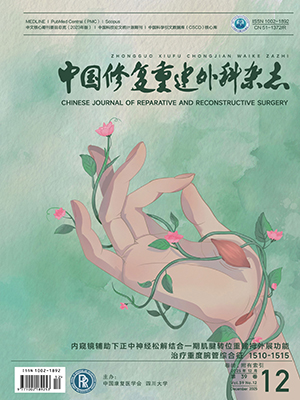| 1. |
唐彬軼, 屈藝, 母得志. 缺氧誘導因子 1α 在缺氧缺血性損傷中的研究進展. 中國修復重建外科雜志, 2009, 23(6): 755-757.
|
| 2. |
張丹, 任利玲. 缺氧誘導因子 1α 在組織工程成骨和成血管中的作用. 中國修復重建外科雜志, 2016, 30(4): 504-506.
|
| 3. |
Thackham JA, McElwain DL, Long RJ. The use of hyperbaric oxygen therapy to treat chronic wounds: A review. Wound Repair Regen, 2008, 16(3): 321-330.
|
| 4. |
聶開瑜, 李鵬程. bFGF 聯合局部氧療促進燒傷創面愈合的臨床觀察. 中國修復重建外科雜志, 2010, 24(6): 643-646.
|
| 5. |
Botusan IR, Sunkari VG, Savu O, et al. Stabilization of HIF-1alpha is critical to improve wound healing in diabetic mice. Proc Natl Acad Sci U S A, 2008, 105(49): 19426-19431.
|
| 6. |
Thangarajah H, Vial IN, Grogan RH, et al. HIF-1alpha dysfunction in diabetes. Cell Cycle, 2010, 9(1): 75-79.
|
| 7. |
Thangarajah H, Yao D, Chang EI, et al. The molecular basis for impaired hypoxia-induced VEGF expression in diabetic tissues. Proc Natl Acad Sci U S A, 2009, 106(32): 13505-13510.
|
| 8. |
Chang EI, Loh SA, Ceradini DJ, et al. Age decreases endothelial progenitor cell recruitment through decreases in hypoxia-inducible factor 1alpha stabilization during ischemia. Circulation, 2007, 116(24): 2818-2829.
|
| 9. |
Liu L, Marti GP, Wei X, et al. Age-dependent impairment of HIF-1alpha expression in diabetic mice: Correction with electroporation-facilitated gene therapy increases wound healing, angiogenesis, and circulating angiogenic cells. J Cell Physiol, 2008, 217(2): 319-327.
|
| 10. |
Loh SA, Chang EI, Galvez MG, et al. SDF-1 alpha expression during wound healing in the aged is HIF dependent. Plast Reconstr Surg, 2009, 123(2 Suppl): 65S-75S.
|
| 11. |
Hoenig MR, Bianchi C, Rosenzweig A, et al. Decreased vascular repair and neovascularization with ageing: mechanisms and clinical relevance with an emphasis on hypoxia-inducible factor-1. Curr Mol Med, 2008, 8(8): 754-767.
|
| 12. |
Schwacha MG, Nickel E, Daniel T. Burn injury-induced alterations in wound inflammation and healing are associated with suppressed hypoxia inducible factor-1alpha expression. Mol Med, 2008, 14(9-10): 628-633.
|
| 13. |
Koh MY, Spivak-Kroizman TR, Powis G. HIF-1alpha and cancer therapy. Recent Results Cancer Res, 2010, 180: 15-34.
|
| 14. |
Hudson CC, Liu M, Chiang GG, et al. Regulation of hypoxia-inducible factor 1 expression and function by the mammalian target of rapamycin. Mol Cell Biol, 2002, 22(20): 7004-7014.
|
| 15. |
Ma D, Lim T, Xu J, et al. Xenon preconditioning protects against renal ischemic-reperfusion injury via HIF-1alpha activation. J Am Soc Nephrol, 2009, 20(4): 713-720.
|
| 16. |
程劍, 張蕾. 缺氧誘導因子 1α 參與異氟醚延遲性預處理減輕小鼠腎臟缺血再灌注損傷的研究. 中國修復重建外科雜志, 2010, 24(4): 477-480.
|
| 17. |
Chen C, Schultz GS, Bloch M, et al. Molecular and mechanistic validation of delayed healing rat wounds as a model for human chronic wounds. Wound Repair Regen, 1999, 7(6): 486-494.
|
| 18. |
Kuppahally S, Al-Khaldi A, Weisshaar D, et al. Wound healing complications withde novo sirolimus versus mycophenolate mofetil-based regimen in cardiac transplant recipients. Am J Transplant, 2006, 6(5 Pt 1): 986-992.
|
| 19. |
Sch?ffer M, Schier R, Napirei M, et al. Sirolimus impairs wound healing. Langenbecks Arch Surg, 2007, 392(3): 297-303.
|
| 20. |
Singh KP, Prasad R, Chari PS, et al. Effect of growth hormone therapy in burn patients on conservative treatment. Burns, 1998, 24(8): 733-738.
|
| 21. |
付小兵. 進一步重視體表慢性難愈合創面發生機制與防治研究. 中華創傷雜志, 2004, 20(8): 449-451.
|




